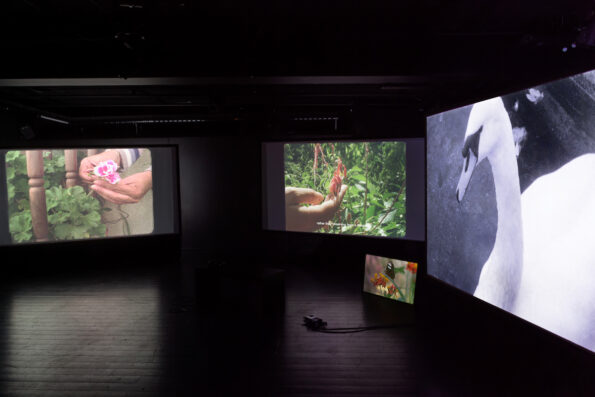Search
To search for an exact match, type the word or phrase you want in quotation marks.
A*DESK has been offering since 2002 contents about criticism and contemporary art. A*DESK has become consolidated thanks to all those who have believed in the project, all those who have followed us, debating, participating and collaborating. Many people have collaborated with A*DESK, and continue to do so. Their efforts, knowledge and belief in the project are what make it grow internationally. At A*DESK we have also generated work for over one hundred professionals in culture, from small collaborations with reviews and classes, to more prolonged and intense collaborations.
At A*DESK we believe in the need for free and universal access to culture and knowledge. We want to carry on being independent, remaining open to more ideas and opinions. If you believe in A*DESK, we need your backing to be able to continue. You can now participate in the project by supporting it. You can choose how much you want to contribute to the project.
You can decide how much you want to bring to the project.

A few months ago I published what was my master’s thesis. I titled it the same as my latest video installation, The holobiont that therefore I am, which can be seen at BIAM (Lo Pati, Amposta), and with videos shown at Chiquita Room in the context of the Loop videoart festival in Barcelona, one of which, The knots we knot, was screened at the Centre Excursionista de Catalunya during the festival.
The holobiont that therefore I am, which can be read here, is a reflection on my work, my interests and my current research on moving images and video installations based on rethinking other ways of looking, inhabiting and representing what we have called nature and its inhabitants. Through examples of practices of care between species and in more than human worlds, based both on personal experiences and from academic and non-academic literature, I think of work that has inspired me and that I think could help us to have a different perspective on ecology.
A holobiont is, in the words of Helen Torres, a biotic community, and refers to a plant or an animal with all its microbiota, that is, all of its associated microorganisms. Etymologically, holo- means complete, total, safe and sound, so holobiont would mean whole beings. Perhaps feeling part of something bigger, part of a networked system, a connected symbiotic entity that is as necessary as any other, part of the holobiont, that is ecology, would make us want to act, to take action.

Film Los nudos que anudamos, Bárbara Sánchez Barroso and Adriana Vila Guevara
This is why we need each other. To think-with, from the collective and with situated thinking, I have invited 4 authors that I admire, whose work I follow and who have been references for my own research. I met them in very diverse and stimulating contexts, and have talked with them about post-humanism, feminism, vibrant matter and more-than-human worlds. Editing their texts has been a way of continuing those conversations:
I met Marjolein Van der Loo thanks to Instagram and her hyperlink tentacles that led me to her master’s thesis, The Vegetable Curator, and I have managed to maintain contact and follow her current adventures in Japan and her research on curatorial plant-based processes of decolonization. In her text, she proposes an exercise in breathing and an agency with those magnificent beings that allow us to obtain oxygen through exchange and collaboration.
Cris Noguer, whom I met thanks to Alicia Kopf’s Expanded Writing workshop, in which she held a small workshop where we went for a walk through the countryside in silence, to later read together the now classic Carrier bag theory of fiction, by Ursula K. Le Guin. In her text, she tells us about her experience as a designer and researcher of new materials, which led her to discover the word Alwé.
Yasmine Ostendorf, whom I met on the Labverde expedition in the Brazilian Amazon, has spent many years exploring the world of mushrooms, so much so that she has become a shiitake farmer and travels around the world researching them. She is currently preparing a book about what mycelium has taught her and her text reveals the secrets about different notions of time and care.
Helen Torres, whom I met at the transhackfeminist conferences in Hangar, but whom I already knew about long before from reading Donna Haraway through her, is present in this issue, thanks to the fact that I was lucky enough to be able to invite her along with Yayo Herrero to a few online talks at the university. Chatting with her is always synonymous not only with learning, but with changing, for example, in regards to the word “attunement” that Vinciane Despret uses to speak in a closer, more empathetic way. In her text, Helen describes the holobiont better than I ever could.
Thanks to these kindred and allied perspectives that have helped me expand my way of seeing the world, and not just seeing but touching and feeling it, and belonging, forming part of a network in which we are all connected.
(Cover image: View of the video installation The Holobiont that therefore I am, Inter Arts Center, Malmö)

Bárbara Sánchez Barroso is a visual artist and researcher, working mainly with moving images and narrative. She has studied art, communication and literature, and what interests her most is telling stories and hearing them told, if possible, in a forest.
https://barbarawong.info/
"A desk is a dangerous place from which to watch the world" (John Le Carré)